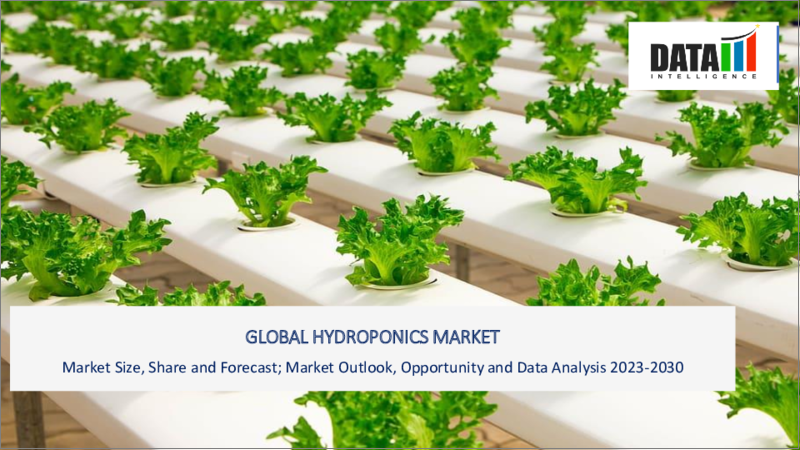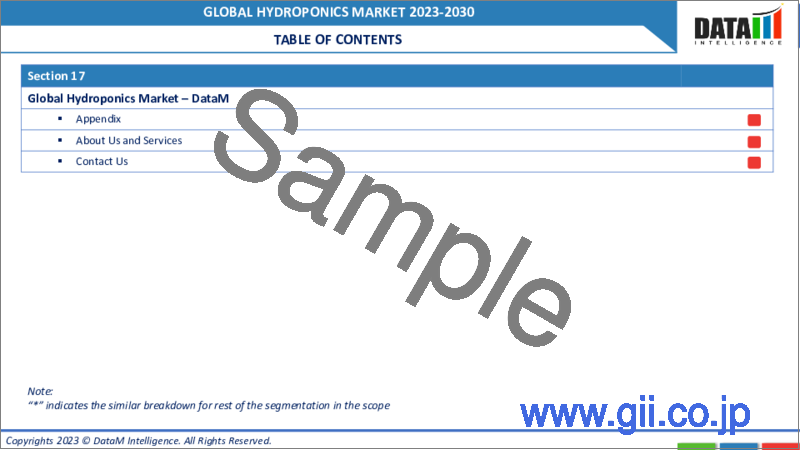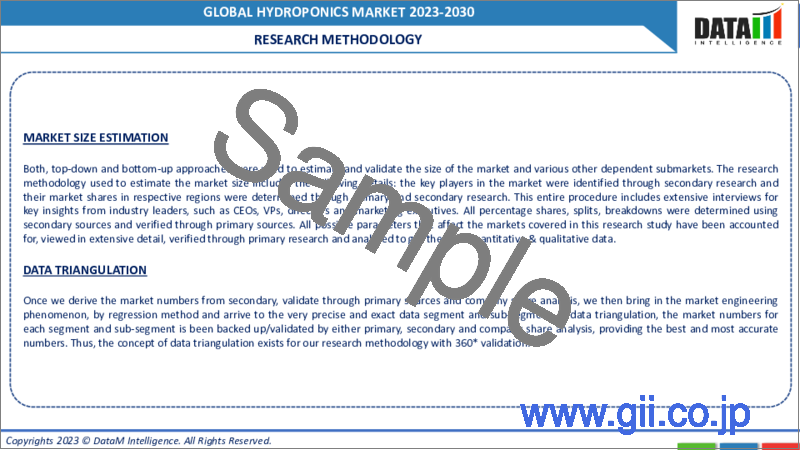|
|
市場調査レポート
商品コード
1297844
水耕栽培の世界市場-2023年~2030年Global Hydroponics Market - 2023-2030 |
||||||
カスタマイズ可能
適宜更新あり
|
|||||||
| 水耕栽培の世界市場-2023年~2030年 |
|
出版日: 2023年06月15日
発行: DataM Intelligence
ページ情報: 英文 140 Pages
納期: 即日から翌営業日
|
- 全表示
- 概要
- 目次
市場概要
世界の水耕栽培市場は、2022年に100億米ドルに達し、2030年には310億米ドルに達し、有利な成長が予測されています。予測期間2023-2030年のCAGRは14.5%です。
水耕栽培市場は近年著しく成長し、大きな注目を集めています。水耕栽培は、水ベースの溶液を通して根に必要な栄養素を直接供給することで植物の成長を最適化する無肥料栽培法として、従来の土壌をベースとした農業よりも多くの利点を提供しています。
持続可能な農法への需要、都市化の進展、作物収量の増加へのニーズが、水耕栽培市場の着実な上昇軌道を後押ししています。水耕栽培市場は、現代農業の課題に対する持続可能なソリューションです。
高品質の農産物に対する消費者の需要の増加、技術の進歩、資源効率の重視により、水耕栽培市場は継続的に拡大する態勢を整えています。水耕栽培市場は、生産者、投資家、農業バリューチェーン全体の利害関係者に機会を提供しています。
市場力学
健康的で有機的な食品への需要の高まりが市場を牽引
市場では、資源消費と環境への影響を最小限に抑える持続可能な農業慣行に対する需要が高まっています。水と養分を効率的に利用する水耕栽培はこの需要に応え、従来の土壌を利用した農業に代わる持続可能な代替手段を提供します。
市場は、資源不足、特に水不足と耕地利用可能性への懸念に対応して、水耕栽培に目を向けています。制御された効率的な水の使用を採用し、必要な土地を減らし、土壌の劣化を最小限に抑えることで、水耕栽培は市場を前進させる態勢を整えています。
技術の進歩が市場成長を牽引
水耕栽培市場は、水耕栽培の技術的進歩による効率性と生産性の向上を目の当たりにしています。自動化と精密制御システムは、光、温度、湿度、栄養レベルなどの環境要因を最適化し、理想的な生育条件を確保します。これにより、成長が加速し、収穫量が増え、作物の品質が向上します。水耕栽培市場は、生産者が高品質製品に対する需要の高まりに対応し、より高い生産性を達成できることから、こうした進歩の恩恵を受けています。
COVID-19の影響分析
パンデミックはサプライチェーンに混乱を引き起こし、水耕栽培システム、機器、および養液、pH計、温度制御装置など、これらの技術に不可欠な投入物の入手に影響を与えました。
しかし、輸入食糧供給に頼ることの脆弱性が認識され、世界・サプライ・チェーンの混乱と相まって、現地生産と食糧安全保障が重視されるようになっています。水耕栽培、特に垂直農法とCEAは、都市部で新鮮な農産物を栽培し、長距離輸送への依存を低減するためのソリューションとして人気を博しました。
人工知能の影響分析
水耕栽培市場における人工知能(AI)の統合は、作物の栽培、監視、管理方法に革命をもたらします。AIは生産者に高度な分析、自動化、意思決定支援を提供し、最終的に水耕栽培の収量、資源効率、持続可能性の向上につながります。
AIベースの画像認識とセンサー技術は、植物の病気、栄養不足、害虫の侵入の初期兆候を検出することができます。これにより、的を絞った治療や環境パラメーターの調整など、タイムリーな介入が可能になり、作物の損失を最小限に抑え、植物の健全性を高めることができます。
目次
第1章 調査手法と範囲
第2章 定義と概要
第3章 エグゼクティブサマリー
第4章 市場力学
- 影響を与える要因
- 促進要因
- 高品質の製品に対する需要の高まりが市場の成長を促進
- 抑制要因
- 高額な初期投資が市場の成長を妨げる
- 機会
- 限られた耕地利用可能性が市場の成長を促進
- 影響分析
- 促進要因
第5章 業界分析
- ポーターのファイブフォース分析
- サプライチェーン分析
- 価格分析
- 規制分析
第6章 COVID-19の分析
第7章 作物別
- トマト
- レタスと葉物野菜
- コショウ
- キュウリ
- マイクログリーン
- その他(果物、花)
第8章 システム別
- 集合水耕栽培システム
- オープンシステム
- クローズドシステム
- 液体水耕栽培システム
第9章 設備別
- 空調設備
- LEDグローライト
- 灌漑システム
- マテリアルハンドリング
- 制御システム
- その他(換気、通信技術)
第10章 サービス別
- 無機水耕液
- 有機水耕液
第11章 地域別
- 北米
- 米国
- カナダ
- メキシコ
- 欧州
- ドイツ
- 英国
- フランス
- イタリア
- スペイン
- その他欧州
- 南米
- ブラジル
- アルゼンチン
- その他南米
- アジア太平洋
- 中国
- インド
- 日本
- オーストラリア
- その他アジア太平洋地域
- 中東とアフリカ
第12章 競合情勢
- 競合シナリオ
- 市場ポジショニング/シェア分析
- 合併と買収の分析
第13章 企業プロファイル
- Bright Farms Inc
- 会社概要
- 製品ポートフォリオと説明
- 財務概要
- 主な発展
- Argus Control Systems Limited
- Hortisystems Uk Ltd
- Kubo Group
- Greentech Organic Hydroponics Systems Mfrs.
- Circle Fresh Farms
- Hydrodynamics International
- Helio spectra AB
- AmHydro
- Growers Supply
第14章 付録
Market Overview
The Global Hydroponics Market reached US$ 10 billion in 2022 and is projected to witness lucrative growth by reaching up to US$ 31 billion by 2030. The market is growing at a CAGR of 14.5% during the forecast period 2023-2030.
The Hydroponics Market has grown remarkably and garnered significant attention in recent years. Hydroponics offers numerous advantages over traditional soil-based farming as a soilless cultivation method that optimizes plant growth by delivering essential nutrients directly to the roots through water-based solutions.
The demand for sustainable agricultural methods, rising urbanization, and the need for greater crop yields are driving the steady upward trajectory of the hydroponics market. The hydroponics market represents a sustainable solution to modern agriculture's challenges.
With increasing consumer demand for quality produce, technological advancements, and a focus on resource efficiency, the hydroponics market is poised for continued expansion. It offers opportunities for growers, investors, and stakeholders across the agricultural value chain.
Market Dynamics
Increasing Demand for Healthy and Organic Food Products Drives the Market
The market is experiencing a growing demand for sustainable agricultural practices that minimize resource consumption and environmental impact. Hydroponics, with its efficient use of water and nutrients, meets this demand and provides a sustainable alternative to traditional soil-based farming.
The market is turning to hydroponics in response to concerns about resource scarcity, particularly water scarcity and arable land availability. By employing controlled and efficient water usage, reducing land requirements, and minimizing soil degradation, hydroponics is poised to drive the market forward.
Technological Advancements Drive the Market Growth
The Hydroponics Market witnesses enhanced efficiency and productivity through technological advancements in hydroponics. Automation and precision control systems optimize environmental factors like light, temperature, humidity, and nutrient levels, ensuring ideal growing conditions. This leads to accelerated growth, higher yields, and improved crop quality. The hydroponics market benefits from these advancements as growers can meet the increasing demand for high-quality products and achieve greater productivity.
COVID-19 Impact Analysis
The pandemic caused disruptions in the supply chain, affecting the availability of hydroponic systems, equipment, and inputs essential for these techniques, such as nutrient solutions, pH meters, and temperature control devices.
However, the realization of vulnerabilities in relying on imported food supplies, coupled with disrupted global supply chains, led to an increased emphasis on local production and food security. Hydroponics, particularly vertical farming, and CEA gained traction as solutions for cultivating fresh produce in urban areas and reducing dependence on long-distance transportation.
Artificial Intelligence Impact Analysis
The integration of Artificial Intelligence (AI) in the hydroponics market revolutionizes the way crops are grown, monitored, and managed. It empowers growers with advanced analytics, automation, and decision support, ultimately leading to increased yields, resource efficiency, and sustainability in hydroponic farming practices.
AI-based image recognition and sensor technologies can detect early signs of plant diseases, nutrient deficiencies, and pest infestations. This enables timely intervention, such as targeted treatments or adjustments to environmental parameters, minimizing crop losses and enhancing plant health.
Segment Analysis
The Global Hydroponics Market is segmented based on crop, system, equipment, service, and region.
Growers' Shifting Toward LED Lighting Systems is Expected to Drive the Segment Growth
LED glowlight has the largest share of the Global Hydroponics Market due to its exceptional features and advantages. The market has witnessed a significant shift towards LED lighting systems in hydroponics due to their superior performance and efficiency.
LED glowlight stands out in the market as it offers enhanced energy efficiency, a longer lifespan, and precise light spectrum control, meeting the specific needs of hydroponic crop cultivation. Its ability to provide optimal light intensity and spectrum for plant growth has led to increased yields, improved crop quality, and reduced energy consumption, positioning LED glowlight as the preferred lighting solution in the market.
Geographical Analysis
Increased Inclination Towards Advanced Agricultural Practices in North America
North America emerged as the dominant force in the global hydroponics market, capturing a significant share. North America exhibited a strong inclination towards advanced agricultural practices, including hydroponics, driven by a focus on sustainability and food security.
The region's favorable climatic conditions, technological advancements, and well-established infrastructure provided a conducive environment for hydroponic farming. The presence of key market players, innovative research and development initiatives, and supportive government policies propelled the growth of the hydroponics industry in North America.
Competitive Landscape
The major global hydroponics market players include: Bright Farms Inc, Argus Control Systems Limited, Hortisystems Uk Ltd, Kubo Group, Greentech Organic Hydroponics Systems Mfrs., Circle Fresh Farms, Hydrodynamics International, Helio spectra AB, AmHydro, and Growers Supply.
Why Purchase the Report?
- To visualize the Global Hydroponics Market segmentation based on crop, system, equipment, service, and region and understand key commercial assets and players.
- Identify commercial opportunities by analyzing trends and co-development.
- Excel data sheet with numerous data points of hydroponics market-level with all segments.
- PDF report consists of a comprehensive analysis after exhaustive qualitative interviews and an in-depth study.
- Product mapping available as Excel consisting of key products of all the major players.
The Global Hydroponics Market Report Would Provide Approximately 69 Tables, 71 Figures And 140 pages.
Target Audience 2023
- Manufacturers/ Buyers
- Industry Investors/Investment Bankers
- Research Professionals
- Emerging Companies
Table of Contents
1. Methodology and Scope
- 1.1. Research Methodology
- 1.2. Research Objective and Scope of the Report
2. Definition and Overview
3. Executive Summary
- 3.1. Snippet by Crop
- 3.2. Snippet by System
- 3.3. Snippet by Equipment
- 3.4. Snippet by Service
- 3.5. Snippet by Region
4. Dynamics
- 4.1. Impacting Factors
- 4.1.1. Drivers
- 4.1.1.1. Rising demand for quality products drives the market growth
- 4.1.2. Restraints
- 4.1.2.1. High initial investment hampers the market growth
- 4.1.3. Opportunity
- 4.1.3.1. Limited arable land availability drives the market growth
- 4.1.4. Impact Analysis
- 4.1.1. Drivers
5. Industry Analysis
- 5.1. Porter's Five Force Analysis
- 5.2. Supply Chain Analysis
- 5.3. Pricing Analysis
- 5.4. Regulatory Analysis
6. COVID-19 Analysis
- 6.1. Analysis of COVID-19
- 6.1.1. Scenario Before COVID-19
- 6.1.2. Scenario During COVID-19
- 6.1.3. Post COVID-19 and Future Scenario
- 6.2. Pricing Dynamics Amid COVID-19
- 6.3. Demand-Supply Spectrum
- 6.4. Government Initiatives Related to the Market During the Pandemic
- 6.5. Manufacturers' Strategic Initiatives
- 6.6. Conclusion
7. By Crop
- 7.1. Introduction
- 7.1.1. Market Size Analysis and Y-o-Y Growth Analysis (%), By Crop
- 7.1.2. Market Attractiveness Index, By Crop
- 7.2. Tomato*
- 7.2.1. Introduction
- 7.2.2. Market Size Analysis and Y-o-Y Growth Analysis (%)
- 7.3. Lettuce and Leafy Vegetables
- 7.4. Pepper
- 7.5. Cucumber
- 7.6. Microgreens
- 7.7. Others (Fruits, Flowers)
8. By System
- 8.1. Introduction
- 8.1.1. Market Size Analysis and Y-o-Y Growth Analysis (%), By System
- 8.1.2. Market Attractiveness Index, By System
- 8.2. Aggregate Hydroponic System*
- 8.2.1. Introduction
- 8.2.2. Market Size Analysis and Y-o-Y Growth Analysis (%)
- 8.2.3. Open System
- 8.2.4. Closed System
- 8.3. Liquid Hydroponic System
9. By Equipment
- 9.1. Introduction
- 9.1.1. Market Size Analysis and Y-o-Y Growth Analysis (%), By Equipment
- 9.1.2. Market Attractiveness Index, By Equipment
- 9.2. HVAC*
- 9.2.1. Introduction
- 9.2.2. Market Size Analysis and Y-o-Y Growth Analysis (%)
- 9.3. LED Glowlight
- 9.4. Irrigation Systems
- 9.5. Material Handling
- 9.6. Control Systems
- 9.7. Others (Ventilation, Communication Technology)
10. By Service
- 10.1. Introduction
- 10.1.1. Market Size Analysis and Y-o-Y Growth Analysis (%), By Service
- 10.1.2. Market Attractiveness Index, By Service
- 10.2. Inorganic Hydroponic Solutions*
- 10.2.1. Introduction
- 10.2.2. Market Size Analysis and Y-o-Y Growth Analysis (%)
- 10.3. Organic Hydroponic Solutions
11. By Region
- 11.1. Introduction
- 11.1.1. Market Size Analysis and Y-o-Y Growth Analysis (%), By Region
- 11.1.2. Market Attractiveness Index, By Region
- 11.2. North America
- 11.2.1. Introduction
- 11.2.2. Key Region-Specific Dynamics
- 11.2.3. Market Size Analysis and Y-o-Y Growth Analysis (%), By Crop
- 11.2.4. Market Size Analysis and Y-o-Y Growth Analysis (%), By System
- 11.2.5. Market Size Analysis and Y-o-Y Growth Analysis (%), By Equipment
- 11.2.6. Market Size Analysis and Y-o-Y Growth Analysis (%), By Service
- 11.2.7. Market Size Analysis and Y-o-Y Growth Analysis (%), By Country
- 11.2.7.1. The U.S.
- 11.2.7.2. Canada
- 11.2.7.3. Mexico
- 11.3. Europe
- 11.3.1. Introduction
- 11.3.2. Key Region-Specific Dynamics
- 11.3.3. Market Size Analysis and Y-o-Y Growth Analysis (%), By Crop
- 11.3.4. Market Size Analysis and Y-o-Y Growth Analysis (%), By System
- 11.3.5. Market Size Analysis and Y-o-Y Growth Analysis (%), By Equipment
- 11.3.6. Market Size Analysis and Y-o-Y Growth Analysis (%), By Service
- 11.3.7. Market Size Analysis and Y-o-Y Growth Analysis (%), By Country
- 11.3.7.1. Germany
- 11.3.7.2. The UK
- 11.3.7.3. France
- 11.3.7.4. Italy
- 11.3.7.5. Spain
- 11.3.7.6. Rest of Europe
- 11.4. South America
- 11.4.1. Introduction
- 11.4.2. Key Region-Specific Dynamics
- 11.4.3. Market Size Analysis and Y-o-Y Growth Analysis (%), By Crop
- 11.4.4. Market Size Analysis and Y-o-Y Growth Analysis (%), By System
- 11.4.5. Market Size Analysis and Y-o-Y Growth Analysis (%), By Equipment
- 11.4.6. Market Size Analysis and Y-o-Y Growth Analysis (%), By Service
- 11.4.7. Market Size Analysis and Y-o-Y Growth Analysis (%), By Country
- 11.4.7.1. Brazil
- 11.4.7.2. Argentina
- 11.4.7.3. Rest of South America
- 11.5. Asia-Pacific
- 11.5.1. Introduction
- 11.5.2. Key Region-Specific Dynamics
- 11.5.3. Market Size Analysis and Y-o-Y Growth Analysis (%), By Crop
- 11.5.4. Market Size Analysis and Y-o-Y Growth Analysis (%), By System
- 11.5.5. Market Size Analysis and Y-o-Y Growth Analysis (%), By Equipment
- 11.5.6. Market Size Analysis and Y-o-Y Growth Analysis (%), By Service
- 11.5.7. Market Size Analysis and Y-o-Y Growth Analysis (%), By Country
- 11.5.7.1. China
- 11.5.7.2. India
- 11.5.7.3. Japan
- 11.5.7.4. Australia
- 11.5.7.5. Rest of Asia-Pacific
- 11.6. Middle East and Africa
- 11.6.1. Introduction
- 11.6.2. Key Region-Specific Dynamics
- 11.6.3. Market Size Analysis and Y-o-Y Growth Analysis (%), By Crop
- 11.6.4. Market Size Analysis and Y-o-Y Growth Analysis (%), By System
- 11.6.5. Market Size Analysis and Y-o-Y Growth Analysis (%), By Equipment
- 11.6.6. Market Size Analysis and Y-o-Y Growth Analysis (%), By Service
12. Competitive Landscape
- 12.1. Competitive Scenario
- 12.2. Market Positioning/Share Analysis
- 12.3. Mergers and Acquisitions Analysis
13. Company Profiles
- 13.1. Bright Farms Inc*
- 13.1.1. Company Overview
- 13.1.2. Product Portfolio and Description
- 13.1.3. Financial Overview
- 13.1.4. Key Developments
- 13.2. Argus Control Systems Limited
- 13.3. Hortisystems Uk Ltd
- 13.4. Kubo Group
- 13.5. Greentech Organic Hydroponics Systems Mfrs.
- 13.6. Circle Fresh Farms
- 13.7. Hydrodynamics International
- 13.8. Helio spectra AB
- 13.9. AmHydro
- 13.10. Growers Supply
LIST NOT EXHAUSTIVE
14. Appendix
- 14.1. About Us and Services
- 14.2. Contact Us





